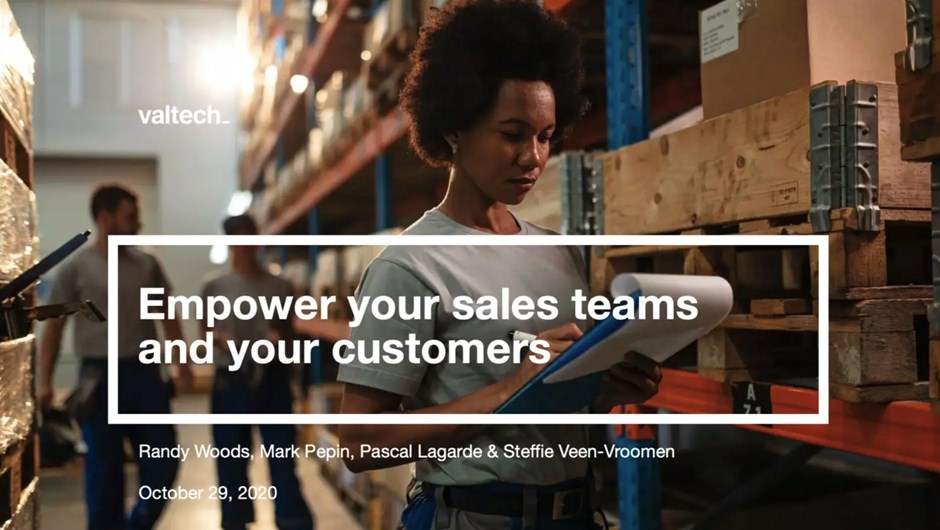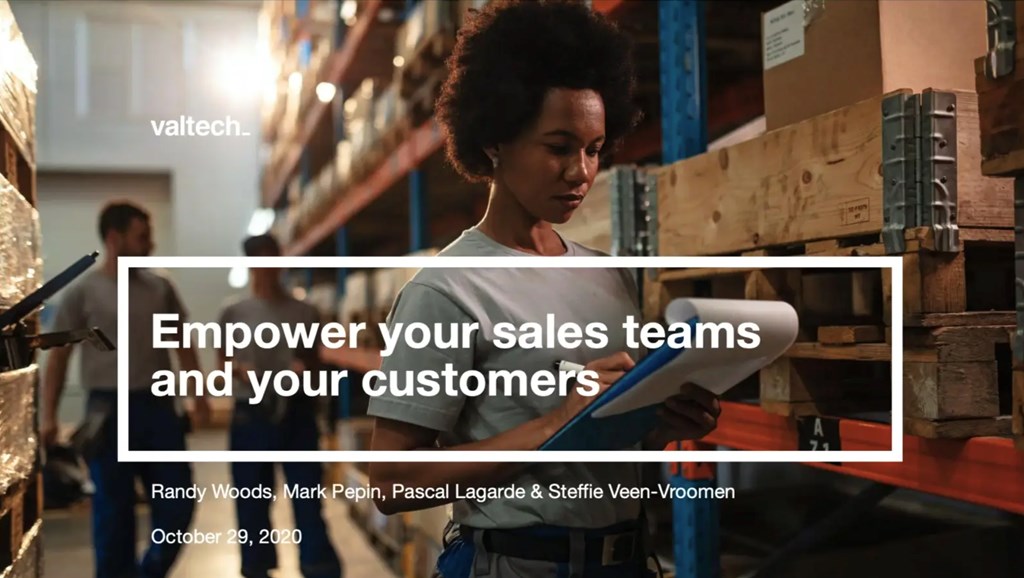
02:30pm - 03:00pm GMT
03:30pm - 04:00pm CET
What the B2B Industry need to do to empower your sales teams and your customers
Last week we talked about how address rising customer expectations and emerging third party marketplaces. In this webinar we were joined by Randy Woods, Mark Pepin, Pascal Lagarde & Steffie Veen-Vroomen to discuss how to empower your sales teams and simplify the lives of your customers.
If you couldn’t make the webinar, here's the full recording, or if you’re short on time, here are our top 3 takeaways.
1. Empower your sales teams
Distributers often employ large traditional sales teams and complex sales processes. There is an opportunity here to become more responsive as an organisation, to reduce the administrative workload and to focus more on relationship building. We know that digital sales enablement can reduce the time you need per client, increase the number of qualified leads and increased customer satisfaction and loyalty, so what are the important things to think about?
“As a wholesaler, manufacturer or distributor with your own distribution channel, you ultimately own the relationship with the end customer– so finding ways to make your sales team more effective is one way of defending yourself against the intrusion of marketplaces and also other competitors”. Randy Woods
- From order takers to advisors: Give your sales reps the information they need, when they need it, to better serve your customers. Free them from routine work so they can spend more time with customers and give them the ability to prioritise higher value tasks and make them more effective with targeted, personalised conversations.
- Personalised tools + reports: Increase lead volumes and improve close rates by leveraging data and insights. Unlock the data and make it easily available to your sales reps to enable them to make better decisions and to respond in a more focused way. Make sure you have streamlined access to information by effectively integrating existing back-end solutions.
- Digital alternatives to events: Even more pertinent in the case of Covid, there are effective digital solutions / alternatives to trade shows, conferences and live meetings. Take the time to really think through how the experience changes when you are sitting behind a desk vs walking around a trade fair.
2. Reduce the friction
We know that no two companies or situations are the same but many B2B companies share common frustrations. They want to reduce the friction experienced by sales reps and customers when using multiple systems, and they want to make it easier for their customers to do business with them. If you can offer your end-customers a flawless experience and value-added services, you can increase loyalty and secure long-term relationships. But how do you do that?
“It’s about connecting and combining various underlying systems e.g. your CRM solution, commerce solution or your ERP data and bringing it all together in a single interface that breaks down siloes and enables your customers and your salesforce to achieve more.” Pascal Lagarde
Here are the things that you need to look out for:
- Surface the information that’s lost in the siloes (e.g., combining CRM and ERP data) whilst also hiding the complexity for the end user. Find new ways to make that information even more relevant to your customers and sales reps.
- Increase efficiency by enabling your sales teams to be more consultative and give them the data insights that will help them make smarter decisions.
- Reduce the friction of self-service by providing the right product data, easy search functionality, order details and personalised offers and incentives.
3. Simplify your customer’s life
Over the last decade, consumers have become used to the concept of 24/7 self-service. Now they expect the same from suppliers. So how can you enable the same level of service in a B2B context, when dealing with multiple buyers from 1 client?
“There’s a convenience factor but there are also real cost savings for the end customer when the whole journey is made more efficient. The customer view is ‘don’t make me think, don’t make me work – you already know a lot about me, leverage that and make it work for me’, that’s where the ability to remove the friction and streamline the experience adds the most value.” Mark Pepin.
Some things to think about:
- B2B Ecommerce: regenerate the customer journey by delivering a commerce solution that can provide near real-time inventory status, personalised pricing, product personalization and a rich content experience.
- 24/Self Service: offer real time insights and an overview of i.e., orders, shipments & invoicing to improve the overall customer experience.
- Straightforward ordering: make placing an order as simple as possible and offer automated & reliable ordering processes.
- Segmentation and personalisation: include individualised and direct offers for B2B buyers to increase the ease of doing business on one hand and to grow customer identification and share of wallet on the other.
Watch the episodes of our distribution revolution webinar series :
- Meeting the challenges of B2B marketplaces
- Fit for the future with agile technologies and organizations

